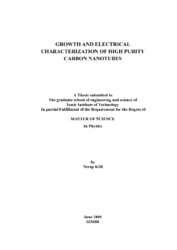Please use this identifier to cite or link to this item:
https://hdl.handle.net/11147/4049Full metadata record
| DC Field | Value | Language |
|---|---|---|
| dc.contributor.advisor | Selamet, Yusuf | - |
| dc.contributor.author | Kır, Serap | - |
| dc.date.accessioned | 2014-07-22T13:53:04Z | - |
| dc.date.available | 2014-07-22T13:53:04Z | - |
| dc.date.issued | 2009 | - |
| dc.identifier.uri | http://hdl.handle.net/11147/4049 | - |
| dc.description | Thesis (Master)--Izmir Institute of Technology, Physics, Izmir, 2009 | en_US |
| dc.description | Includes bibliographical references (leaves: 56-66) | en_US |
| dc.description | Text in English; Abstract:Turkish and English | en_US |
| dc.description | xi, 66 leaves | en_US |
| dc.description.abstract | This thesis work is focused on growing high purity vertically aligned Carbon nanotubes by ethylene gas thermal chemical vapor deposition method on very thin Cobalt and Iron catalyst thin films deposited on to Si/SiO2/Al2O3 substrates by DC magnetron sputtering. In this study, the effective parameters were changed to grow aligned CNTs. Hence, the vertically aligned CNTs were performed and also the ideal parameters were determined for this kind of growth mechanism. The effect of support layer was examined for three different hydrocarbon gas ratios. SiO2 and Al2O3 were used as support layers between metal catalyst thin films and Si substrate. Two kinds of samples were compared; one of them had only Al2O3 and the other one includes both Al2O3 and SiO2 layers. As a result, the sample that had both oxide layers gave better results for density of CNTs on the surface of samples. Moreover, types of catalyst material effect also were examined on growth of CNTs for three different temperatures. For this aim, the performance of Fe and Co catalyst thin films was compared. According to our results, Fe was more reactive with ethylene gas than Co catalysts and also, the density of CNTs was increased by using Fe as a catalyst material. Hydrogen pretreatment time was performed for another significant effect. Seven different time parameter which were 0, 5, 10, 15, 20, 25, 30 minutes, were examined. The density and diameters of catalysts particles were compared for these different treatment times. Finally, the electrical characterization of CNTs was performed. The resistance of CNTs was measured by using two point contact technique. Moreover, the interaction between resistance of CNTs and humidity was examined. | en_US |
| dc.language.iso | en | en_US |
| dc.publisher | Izmir Institute of Technology | en_US |
| dc.rights | info:eu-repo/semantics/openAccess | en_US |
| dc.subject.lcc | QC176.8.N35 .K89 2009 | en |
| dc.subject.lcsh | Nanostructures | en |
| dc.subject.lcsh | Nanotubes | en |
| dc.subject.lcsh | Carbon | en |
| dc.subject.lcsh | Catalysis | en |
| dc.title | Grawth and Electrical Characterization of High Purity Carbon Nanotubes | en_US |
| dc.type | Master Thesis | en_US |
| dc.institutionauthor | Kır, Serap | - |
| dc.department | Thesis (Master)--İzmir Institute of Technology, Physics | en_US |
| dc.relation.publicationcategory | Tez | en_US |
| dc.identifier.wosquality | N/A | - |
| dc.identifier.scopusquality | N/A | - |
| item.openairecristype | http://purl.org/coar/resource_type/c_18cf | - |
| item.languageiso639-1 | en | - |
| item.openairetype | Master Thesis | - |
| item.grantfulltext | open | - |
| item.fulltext | With Fulltext | - |
| item.cerifentitytype | Publications | - |
| Appears in Collections: | Master Degree / Yüksek Lisans Tezleri | |
Files in This Item:
| File | Description | Size | Format | |
|---|---|---|---|---|
| T000213.pdf | MasterThesis | 9.74 MB | Adobe PDF |  View/Open |
CORE Recommender
Page view(s)
188
checked on Mar 31, 2025
Download(s)
78
checked on Mar 31, 2025
Google ScholarTM
Check
Items in GCRIS Repository are protected by copyright, with all rights reserved, unless otherwise indicated.